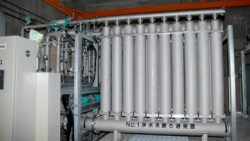Liquid Chromatography for PFAS: Advanced Analytical Techniques for Environmental Monitoring
Introduction
The presence of per- and polyfluoroalkyl substances (PFAS) in water systems has become one of the most concerning environmental challenges of the 21st century. These compounds, often referred to as "forever chemicals" due to their persistence in the environment, have been identified as potential health hazards by multiple regulatory agencies, including the U.S. Environmental Protection Agency (EPA). As of July 2025, there is an urgent need for precise and efficient methods to analyze and monitor PFAS levels in various water sources. Liquid chromatography (LC) has emerged as a critical analytical tool in this endeavor, thanks to its ability to separate and quantify trace levels of these contaminants. This article delves into the intricacies of liquid chromatography for PFAS analysis, addressing its methodologies, challenges, and regulatory implications.
Understanding PFAS: Challenges in Analysis
What Are PFAS?
PFAS are a class of synthetic chemicals that include over 4,700 individual compounds, with notable representatives being perfluorooctanoic acid (PFOA) and perfluorooctanesulfonic acid (PFOS). Their unique molecular structure, featuring carbon-fluorine bonds, imparts properties such as water and oil repellency, making them widely used in various applications, from firefighting foam to food packaging. However, these properties also contribute to their persistence in the environment.
Health Implications and Regulatory Landscape
Recent studies have linked PFAS exposure to various health issues, including cancer, liver damage, immunotoxicity, and developmental problems. In response, the EPA and environmental agencies worldwide have established more stringent regulations regarding PFAS levels in drinking water. In March 2025, for instance, the EPA issued new enforceable standards to limit PFAS concentrations to 4 parts per trillion (ppt), reflecting the growing recognition of their hazardous nature.
The Role of Liquid Chromatography
Liquid chromatography has proven to be an essential technique for the analysis of PFAS due to its high sensitivity, specificity, and versatility. Unlike gas chromatography, LC effectively handles the polar and thermally labile nature of many PFAS, making it more suitable for environmental applications.
Types of Liquid Chromatography
In the context of PFAS analysis, several types of liquid chromatography are employed:
-
High-Performance Liquid Chromatography (HPLC): This method is widely used for its ability to separate complex mixtures. HPLC can efficiently separate anions and cations present in PFAS samples using various column chemistries.
-
Ultra-High Performance Liquid Chromatography (UHPLC): This is a more advanced form of HPLC that offers increased resolution and speed of analysis. UHPLC can be essential for environmental monitoring given the extremely low concentrations of PFAS that must be measured.
- Ion Chromatography (IC): Often used in conjunction with HPLC, IC specifically targets ionic analytes, making it particularly useful in analyzing shorter-chain PFAS compounds.
Methodological Approaches
Combining liquid chromatography with mass spectrometry (LC-MS) has become the gold standard for PFAS analysis. LC-MS not only separates but also provides quantitative and qualitative data on the presence of PFAS in water samples.
Sample Preparation
Effective PFAS analysis requires meticulous sample preparation to ensure the integrity of the analytes:
- Solid Phase Extraction (SPE): This technique allows for the concentration of PFAS from large volumes of water, minimizing matrix effects during LC-MS analysis.
- Liquid-Liquid Extraction (LLE): While less common due to potential solvent remnants, LLE is sometimes employed for specific PFAS analyses.
Data Interpretation
The interpretation of LC-MS data is critical for accurate identification and quantification. The use of internal standards, appropriate calibration curves, and reference materials ensures reliability. Method detection limits (MDLs) are also crucial; recent advancements in LC-MS technology have decreased MDLs to as low as 0.1 ppt for specific PFAS, meeting regulatory requirements.
Barriers and Solutions in PFAS Analysis
Complexity of PFAS Mixtures
Due to the vast array of PFAS compounds, analytical methods must account for uniqueinterferences and co-elution issues. Analysts often encounter challenges with compounds that behave similarly, complicating separation.
Solution: Method Validation and Standardization
Regulatory bodies have initiated projects to standardize PFAS analytical methods. The EPA’s Method 537.1, for instance, outlines the requisite steps for method validation, establishing a baseline for environmental laboratories.
Compliance with Regulations
Laboratories must adopt compliant analytical procedures to meet new EPA regulations. This involves rigorous method validation and maintaining proper Quality Assurance/Quality Control (QA/QC) protocols.
The Future of Liquid Chromatography for PFAS
Technological Advancements
As the analytical challenges evolve, liquid chromatography continues to advance with:
- Miniaturization: Emerging techniques such as micro-chromatography are being explored for on-site monitoring of PFAS in drinking water.
- Data Analytics: Machine learning algorithms are increasingly being applied to improve data interpretation and automate routine analyses, reducing human error and analysis time.
Integration with Other Technologies
A trend toward integrating LC with complementary technologies (e.g., real-time PCR for biomonitoring) may provide comprehensive datasets to further understand PFAS dynamics in various ecosystems.
Conclusion
Liquid chromatography has proven to be an indispensable tool for analyzing PFAS in environmental samples. Given the stringent federal regulations and the rising concern regarding public health, it is crucial for environmental engineers, laboratory technicians, and municipal officials to stay informed about analytical developments and method updates. Successfully implementing LC methods can significantly enhance monitoring efforts, enabling swift actions to mitigate PFAS contamination threats. As technologies continue to evolve, the adaptation of these methods will play a pivotal role in safeguarding water quality and public health.
By understanding the intricacies of liquid chromatography for PFAS, stakeholders can harness the power of advanced analytical techniques to combat one of the most pressing environmental challenges of our time.
source https://www.waterandwastewater.com/liquid-chromatography-for-pfas/


No comments:
Post a Comment